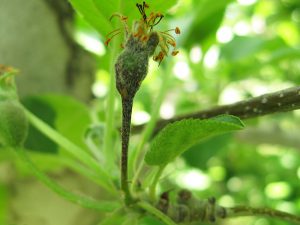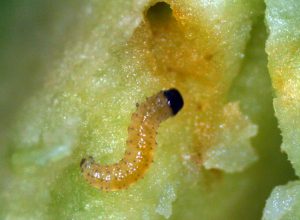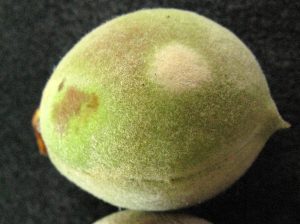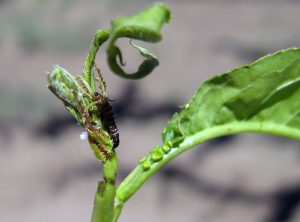In this Issue:
- Apple, Pear: fire blight warnings; codling moth dates available
- Peach/Nectarine, Apricot, Plum: peach powdery mildew and coryneum blight fungicide at shuck split stage; peach twig borer spray dates for southern Utah; greater peachtree borer
- COVID-19 Resources for Commercial Agriculture
APPLE, PEAR
Fire Blight
infections likely happened on open blossoms Friday, May 1; apply antibiotic where needed

We discussed fire blight in our last advisory, and that the warm temperatures this week were conducive to infection. At the time the advisory was written, there was no rain in the forecast, but boy, was the forecast wrong!
Many areas along the Wasatch Front saw some heavy rain today (Friday, May 1). This moisture, combined with the exceptional temperatures of the last few days, was the perfect scenario for fire blight infections (especially where it occurred last year).
If you HAVE applied an antibiotic within the last 2 to 3 days, your trees should have been protected and you do not need to do anything.
If you have NOT sprayed within 2 to 3 days, then apply streptomycin now. It is an antibiotic spray that is sold in most garden centers. It has some “curative” effects if applied within 24 hours of a rain event.
For ALL counties along the Wasatch Front, the fire blight infection risk continues to be EXTREME through May 3. Again, this risk only applies to trees with open flowers.
Starting Monday, May 4, the infection risk goes to HIGH for the next 4 days, and infections could still happen when there is a rain event, so keep an eye on the forecast.
You can watch fire blight predictions on the Utah TRAPs website by selected a location closest to you, and then selecting Fire Blight in the ‘Pest’ drop-down.
Codling Moth
egg hatch prediction dates provided for several locations

Codling moth treatment timing is coming up in late May for many areas of northern Utah. We will provide information about the remaining locations once we have captured moths in our traps.
View a pdf of the spray timing table. Be sure to read the instructions at the top of the page, for how to read the table.
Not all Utah locations are provided on the table. Select your closest city, or, go to the Utah TRAPs website, select your city, and select “Codling Moth-Fixed Biofix” from the drop-down menu.
On the table in the link above, there are two options provided for your first application. “Option A” is standard procedure, where you apply the insecticide you choose at the date provided.
“Option B” uses horticultural oil (at 1% concentration in water) as the first application on the date provided, followed by an insecticide application about 2 weeks later. This option saves one general insecticide spray because the oil kills (smothers) all codling moth eggs laid up to that point, and ideally before any of them have hatched.
For either option, it is recommended to repeat the application to protect fruit at least through the “period of greatest egg hatch” (dates shown on the table).
Treatment
Options for commercial growers.
Options for residential growers (On this April 10, 2020 advisory, scroll down to the Codling Moth heading and see the table).
As we mentioned in the April 10 advisory, the only non-spray option for clean fruit is to bag them (click here and here for more info on bagging fruit), and that would be done when you thin the fruit after bloom, or when they are about 0.5″ diameter.
For strategies on how often to spray for codling moth, it will depend on whether you are using organic or non-organic options, AND how heavily your apples or pears have been infested with codling moth in the past.
Conventional production options
- High fruit damage in past years:
- Apply the first application for either Option A (insecticide) or Option B (oil).
- For Option A, repeat the insecticide spray 14 days later, for a total of 2 applications in the first generation.
- For Option B, apply the insecticide spray at the listed date once.
- When the “start date” for the 2nd generation is provided, spray every 10-18 days until Sept. 15.
- Pick a different product to use for each generation.
- Low fruit damage in past years:
- Apply the first application for either Option A (insecticide) or Option B (oil).
- For Option A, do not spray again.
- For Option B, apply insecticide at the listed date.
- Wait until the “start date” for the 2nd generation is provided, and spray on that date, and repeat 14 days later, for a total of 2 sprays.
- Do the same for the 3rd generation.
- Pick a different product to use for each generation.
Organic production options (other than bagging)
- High fruit damage in past years:
- Apply the first application for either Option A (insecticide) or Option B (oil).
- For Option A, repeat twice, spaced 7-10 apart, for a total of 3 applications in the first generation.
- For Option B, apply insecticide at the listed date and re-apply 7-10 days later.
- When the “start date” for the 2nd generation is provided, spray every 7-10 days until Sept. 15.
- Pick a different product to use for each generation.
- Low fruit damage in past years:
- Apply the first application for either Option A (insecticide) or Option B (oil).
- When the “start date” for the 2nd generation is provided, spray every 10-14 days until Sept. 15.
- Pick a different product to use for each generation.
PEACH, NECTARINE, APRICOT
Peach Powdery Mildew
apply fungicide at shuck split stage

There are two fungal species that cause powdery mildew (PM) on peach. One is specific to peach (Sphaerotheca pannosa), affecting the foliage and fruit, and the other is apple powdery mildew (Podosphaera leucotricha), that only affects the fruit.
Peach PM overwinters on roses and sometimes on peach buds and bark. In spring, when nights are cool and moist, and days are warm, spores infect foliage (rarely) and peach fruitlets. On fruit, new lesions look like fuzzy, bright white spots. Fruit infections can occur all spring until the pit hardening stage. (The only way to tell pit-hardening is to slice peaches.) Infections on leaves are typically only seen later in the season.
Apple PM on peach is referred to as “rusty spot.” The fungus overwinters on apples only, and fruit of peach trees grown near apple trees with PM may be affected. On peach fruit, new lesions look pale whitish at first, and within a few days, the skin under the infection takes on a rusty-orange streaking.
Infections of either disease won’t be noticeable on fruit until 2 to 4 weeks after bloom. At that time, monitor 25 fruits on several trees for the presence of round, whitish, powdery spots on the fruit surface. A total of 10 to 20 fruit infections and greater than 20 fruit infections per tree represents moderate and high risk, respectively.
Susceptible varieties include Redskin, Rio Oso Gem, Elegant Lady, Fairtime, Fay Elberta, and Summerset.
Peach powdery mildew can be prevented with a shuck-split or shuck-fall fungicide application.
Treatment
Find options for commercial growers by clicking here.
In residential settings, fruit that was infected is still edible to eat. If aesthetics is a concern, chlorothalonil or sulfur (organic) can be used (and will also help manage coryneum blight) at the shuck split stage. If a fungicide is needed after shuck split, use sulfur or Spectracide Immunox.
Continue fungicide sprays on susceptible varieties at 10 to 14-day intervals until the pit hardening stage is reached.
Peach Twig Borer

peach, nectarine, apricot – spray dates for some areas of southern Utah
Peach twig borer is active in the warmest southern Utah locations. This pest prefers to feed inside succulent peach shoots, but later in the summer, it feeds inside the fruits themselves. It is best to knock the population down early rather than waiting until later.
Application timing dates:
- Hurricane: May 13
- Zions Canyon area: May 16
- Leeds: May 16
- St. George: May 12
COVID-19 INFORMATION FOR COMMERCIAL PRODUCERS
Although the following information is not pest-related, we wanted to share this with you. It applies to all commercial agriculture, not just fruit crops.
There is a new grant program for farmers affected by COVID-19, available through the Utah Department of Agriculture. The money comes from the CARES act, but was designated for this program in State Bill 3006. It provides grants to farmers for up to $40,000. If farmers got a SBA PPP loan, then the amount they can ask for is less.
Apply by downloading the forms from the UDAF website by May 15.
Proposals will be reviewed and funds should flow in June. It is a 3-page application showing loss from COVID-19 and some supporting documentation. The UDAF conservation staff have been trained to help with the application process.
Other COVID-19 Agricultural Resources:
- USU Extension website that has information on farm tax in relation to COVID-19: http://ruraltax.org/covid-19
- USDA website for farmer assistance: https://www.farmers.gov/coronavirus
- A comprehensive listing of COVID-19 resources for direct market farms: https://extension.usu.edu/covid-19/resources-for-direct-marketing-farmers
- USU Extension information for Farmer’s Markets: “COVID-19 Response and Utah Farmers Market Network Best Practices”
- Marketing in Motion blogs at: https://extension.usu.edu/apec/
